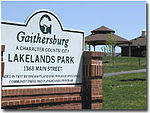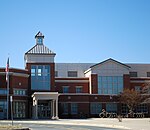Kentlands, Gaithersburg, Maryland

Kentlands is a neighborhood of the U.S. city of Gaithersburg, Maryland. Kentlands was one of the first attempts to develop a community using Traditional Neighborhood Design planning techniques (also known as 'neo-traditional new town planning') that are now generally referred to under the rubric of the New Urbanism. (The New Urbanism is the concept of building a walkable, mixed-use city neighborhood or new town to provide an attractive alternative to the spread out, automobile-centric, subdivisions common to post-World War II American suburbia.) Kentlands is built around a farmstead previously owned by Otis Beall Kent. The development, begun in 1988, contains buildings from the original Kentlands farm, many varieties of residences, a "downtown" commercial district, open space including protected natural areas and pocket parks, and civic uses including schools, a church, clubhouse, pool, tennis and basketball courts, catering facility, and an arts center.
Excerpt from the Wikipedia article Kentlands, Gaithersburg, Maryland (License: CC BY-SA 3.0, Authors, Images).Kentlands, Gaithersburg, Maryland
Lynette Street, Gaithersburg Kentlands
Geographical coordinates (GPS) Address Nearby Places Show on map
Geographical coordinates (GPS)
| Latitude | Longitude |
|---|---|
| N 39.118611111111 ° | E -77.235833333333 ° |
Address
Lynette Street 448-468
20878 Gaithersburg, Kentlands
Maryland, United States
Open on Google Maps








